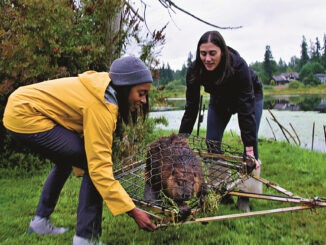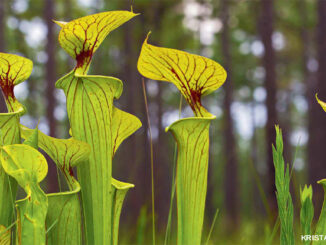
Interview with a Seahorse
By Ranger Rick Raccoon, with help from Kathy KrankingHi, it’s reporter Ranger Rick here. Today I’m getting the scoop on seahorses from a real expert: my friend Sherman Seahorse. So here’s everything you want to know—right from the horse’s—er, I mean seahorse’s mouth!
Ranger Rick: Some people think you seahorses are really tiny, swimming horses. Would you care to comment?
Sherman Seahorse: As you know, Rick, seahorses are fishes! There are 38 different species of us. We live in warm, shallow waters, hanging out in grasses, seaweed, coral, or sponges.
Rick: Wow! I guess people are confused because you sure don’t look like a fish!
Sherman: We’re different from other fishes in more than just looks. You might say we’re the oddballs of the fish world. But we don’t mind. All our differences make us what we are: unique!
Take our bodies, for example. Seahorses aren’t shaped like most other fishes. And unlike most fishes, we don’t have scales. Under our skin, we’re covered with hard, bony plates. It’s kind of like we’re wearing suits of armor! That can help keep us safe from enemies.
Rick: That’s great, Sherman. Are you guys good swimmers?
Sherman: Swimming is another way we’re different, Rick. Most fishes swim by wiggling their bodies and tails from side to side. But a seahorse swims by fluttering a tiny fin on its back and steering with tiny fins on the sides of its head. We’re no racehorses, though: It can take some kinds of seahorses more than a minute to swim just 12 inches! You might say we live life in the slow lane. But that works just fine for us. We spend most of our time hiding. And our slow movements can keep enemies from noticing us.
Rick: How big do seahorses get, Sherman?
Sherman: We come in lots of different sizes. The seahorse behind you is the biggest. It can grow to be as long as a hammer. The smallest are the cuties below me. When full-grown, each is only the length of a staple!
Rick: So, Sherman, what do seahorses do all day?
Sherman: Well, we spend most of our time just hanging on to things. That’s where our talented tails come in. They’re kind of like hands. We curl them around coral, plants, or other things and hold on tight.
Rick: Cool! I wish I could do that with my tail. Do you have any other tricks?
Sherman: Sure! We also have super snouts! A seahorse uses its long snout like a straw to suck tiny creatures and other food into its mouth. Seahorses have no teeth, so we just swallow our food whole. Each of us can eat as many as 3,000 tiny creatures a day!
But that’s not all. We seahorses also have tricky eyes. We can move them in opposite directions at the same time. That means one eye can look for food while the other watches for danger. Check out the seahorse and me at right—you won’t believe your eyes! I mean, our eyes . . . I mean—well, you know what I mean.
Rick: Ha-ha, that’s awesome, Sherman. Speaking of danger, what do you do to stay safe from enemies?
Sherman: To protect ourselves from crabs, fish, birds, and other creatures that might attack us, we use our trickiest trick: We disappear! Most seahorses can change color to match their surroundings. We can turn red, yellow, white, orange, or even purple. And some of us have spines, bumps, or other growths. These can help us match coral, sponges, or whatever we’re hiding in. See how well the seahorse in the bottom right corner blends in with the sea fan surrounding it? It’s a great way to fool animals that might want to eat us, as well as animals we might want to eat!
Rick: Wow, seahorses sure are amazing fishes, Sherman. I guess that’s all the questions I have. Thanks for—
Sherman: Whoa—wait a minute, Rick! We haven’t even gotten to the most amazing thing of all about us. And here it is: Unlike other animals, seahorse moms aren’t the ones that have the babies. Instead, the seahorse dads do it!
Rick: What? How does that even happen?
Sherman: Well, a seahorse dad has a special pouch for the babies. But that’s getting ahead of things. It all starts with a dance.
Rick: A dance?
Sherman: Yup—a male and female seahorse will spend days swimming together in a slow-motion “mating dance.” During this time, they may change color and will even hold on to each other with their tails. It’s all to say, “We’re mates.” You can see a pair dancing above right.
Rick: That’s so cool Sherman. What else happens?
Sherman: The male seahorse fills his pouch with water to show the female he’s ready to mate. Then the female swims up and presses against him. She puts her egg-laying tube, called an ovipositor (oh-vuh-POZ-ih-tur), into an opening in the male’s pouch. Then she lays her eggs in the pouch, just as the seahorse is doing in the heart-shaped photo. The male then fertilizes the eggs in the pouch.
Rick: That’s amazing. Then what happens?
Sherman: Depending on the species, the dad seahorse has “babies on board” for the next two to four weeks. Then, when the time is right, he’ll begin bending his body back and forth and squeezing as hard as he can. This may go on for hours, until finally a tiny head or tail pokes out of the pouch. After a little more squeezing—pop!—out comes a baby seahorse, a “mini-me” of its mom and dad. The dad keeps squeezing out more and more babies until his pouch is empty. Check out the seahorse dad surrounded by his kids in the bottom right photo.
Rick: Awww—they’re so cute!
Sherman: Once they’re out, the babies swim off on their own, find something to hang on to, and begin their new lives.
Rick: Thanks so much for talking to me today, Sherman. Wow—I never knew seahorses were so interesting. I think they’re my new favorite fishes!
Sherman: What a coincidence—mine, too!
“Interview with a Seahorse” originally appeared in the April 2017 issue of Ranger Rick magazine.



















